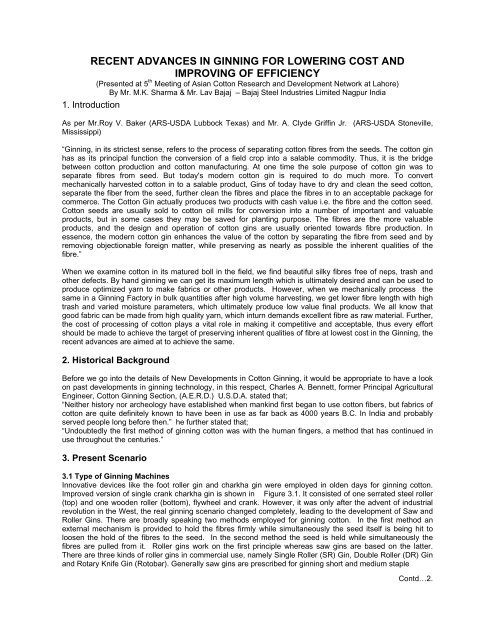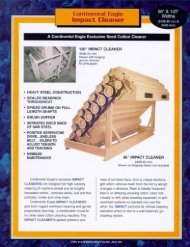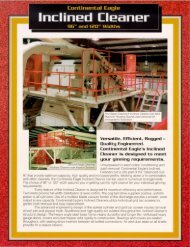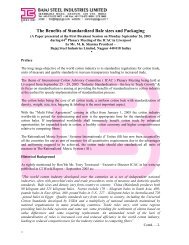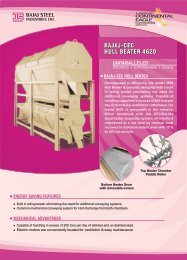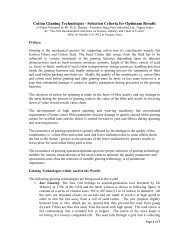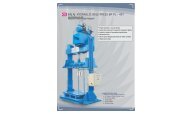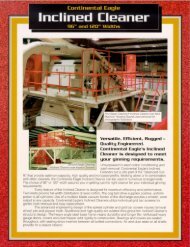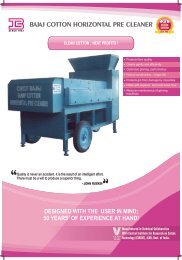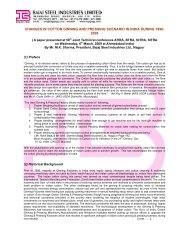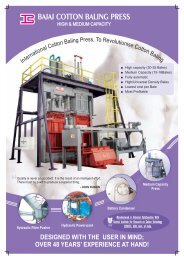recent advances in ginning for lowering cost and ... - Bajaj Group
recent advances in ginning for lowering cost and ... - Bajaj Group
recent advances in ginning for lowering cost and ... - Bajaj Group
Create successful ePaper yourself
Turn your PDF publications into a flip-book with our unique Google optimized e-Paper software.
RECENT ADVANCES IN GINNING FOR LOWERING COST AND<br />
IMPROVING OF EFFICIENCY<br />
(Presented at 5 th Meet<strong>in</strong>g of Asian Cotton Research <strong>and</strong> Development Network at Lahore)<br />
By Mr. M.K. Sharma & Mr. Lav <strong>Bajaj</strong> – <strong>Bajaj</strong> Steel Industries Limited Nagpur India<br />
1. Introduction<br />
As per Mr.Roy V. Baker (ARS-USDA Lubbock Texas) <strong>and</strong> Mr. A. Clyde Griff<strong>in</strong> Jr. (ARS-USDA Stoneville,<br />
Mississippi)<br />
“G<strong>in</strong>n<strong>in</strong>g, <strong>in</strong> its strictest sense, refers to the process of separat<strong>in</strong>g cotton fibres from the seeds. The cotton g<strong>in</strong><br />
has as its pr<strong>in</strong>cipal function the conversion of a field crop <strong>in</strong>to a salable commodity. Thus, it is the bridge<br />
between cotton production <strong>and</strong> cotton manufactur<strong>in</strong>g. At one time the sole purpose of cotton g<strong>in</strong> was to<br />
separate fibres from seed. But today's modern cotton g<strong>in</strong> is required to do much more. To convert<br />
mechanically harvested cotton <strong>in</strong> to a salable product, G<strong>in</strong>s of today have to dry <strong>and</strong> clean the seed cotton,<br />
separate the fiber from the seed, further clean the fibres <strong>and</strong> place the fibres <strong>in</strong> to an acceptable package <strong>for</strong><br />
commerce. The Cotton G<strong>in</strong> actually produces two products with cash value i.e. the fibre <strong>and</strong> the cotton seed.<br />
Cotton seeds are usually sold to cotton oil mills <strong>for</strong> conversion <strong>in</strong>to a number of important <strong>and</strong> valuable<br />
products, but <strong>in</strong> some cases they may be saved <strong>for</strong> plant<strong>in</strong>g purpose. The fibres are the more valuable<br />
products, <strong>and</strong> the design <strong>and</strong> operation of cotton g<strong>in</strong>s are usually oriented towards fibre production. In<br />
essence, the modern cotton g<strong>in</strong> enhances the value of the cotton by separat<strong>in</strong>g the fibre from seed <strong>and</strong> by<br />
remov<strong>in</strong>g objectionable <strong>for</strong>eign matter, while preserv<strong>in</strong>g as nearly as possible the <strong>in</strong>herent qualities of the<br />
fibre.”<br />
When we exam<strong>in</strong>e cotton <strong>in</strong> its matured boll <strong>in</strong> the field, we f<strong>in</strong>d beautiful silky fibres free of neps, trash <strong>and</strong><br />
other defects. By h<strong>and</strong> g<strong>in</strong>n<strong>in</strong>g we can get its maximum length which is ultimately desired <strong>and</strong> can be used to<br />
produce optimized yarn to make fabrics or other products. However, when we mechanically process the<br />
same <strong>in</strong> a G<strong>in</strong>n<strong>in</strong>g Factory <strong>in</strong> bulk quantities after high volume harvest<strong>in</strong>g, we get lower fibre length with high<br />
trash <strong>and</strong> varied moisture parameters, which ultimately produce low value f<strong>in</strong>al products. We all know that<br />
good fabric can be made from high quality yarn, which <strong>in</strong>turn dem<strong>and</strong>s excellent fibre as raw material. Further,<br />
the <strong>cost</strong> of process<strong>in</strong>g of cotton plays a vital role <strong>in</strong> mak<strong>in</strong>g it competitive <strong>and</strong> acceptable, thus every ef<strong>for</strong>t<br />
should be made to achieve the target of preserv<strong>in</strong>g <strong>in</strong>herent qualities of fibre at lowest <strong>cost</strong> <strong>in</strong> the G<strong>in</strong>n<strong>in</strong>g, the<br />
<strong>recent</strong> <strong>advances</strong> are aimed at to achieve the same.<br />
2. Historical Background<br />
Be<strong>for</strong>e we go <strong>in</strong>to the details of New Developments <strong>in</strong> Cotton G<strong>in</strong>n<strong>in</strong>g, it would be appropriate to have a look<br />
on past developments <strong>in</strong> g<strong>in</strong>n<strong>in</strong>g technology, <strong>in</strong> this respect, Charles A. Bennett, <strong>for</strong>mer Pr<strong>in</strong>cipal Agricultural<br />
Eng<strong>in</strong>eer, Cotton G<strong>in</strong>n<strong>in</strong>g Section, (A.E.R.D.) U.S.D.A. stated that;<br />
“Neither history nor archeology have established when mank<strong>in</strong>d first began to use cotton fibers, but fabrics of<br />
cotton are quite def<strong>in</strong>itely known to have been <strong>in</strong> use as far back as 4000 years B.C. In India <strong>and</strong> probably<br />
served people long be<strong>for</strong>e then.” he further stated that;<br />
“Undoubtedly the first method of g<strong>in</strong>n<strong>in</strong>g cotton was with the human f<strong>in</strong>gers, a method that has cont<strong>in</strong>ued <strong>in</strong><br />
use throughout the centuries.”<br />
3. Present Scenario<br />
3.1 Type of G<strong>in</strong>n<strong>in</strong>g Mach<strong>in</strong>es<br />
Innovative devices like the foot roller g<strong>in</strong> <strong>and</strong> charkha g<strong>in</strong> were employed <strong>in</strong> olden days <strong>for</strong> g<strong>in</strong>n<strong>in</strong>g cotton.<br />
Improved version of s<strong>in</strong>gle crank charkha g<strong>in</strong> is shown <strong>in</strong> Figure 3.1. It consisted of one serrated steel roller<br />
(top) <strong>and</strong> one wooden roller (bottom), flywheel <strong>and</strong> crank. However, it was only after the advent of <strong>in</strong>dustrial<br />
revolution <strong>in</strong> the West, the real g<strong>in</strong>n<strong>in</strong>g scenario changed completely, lead<strong>in</strong>g to the development of Saw <strong>and</strong><br />
Roller G<strong>in</strong>s. There are broadly speak<strong>in</strong>g two methods employed <strong>for</strong> g<strong>in</strong>n<strong>in</strong>g cotton. In the first method an<br />
external mechanism is provided to hold the fibres firmly while simultaneously the seed itself is be<strong>in</strong>g hit to<br />
loosen the hold of the fibres to the seed. In the second method the seed is held while simultaneously the<br />
fibres are pulled from it. Roller g<strong>in</strong>s work on the first pr<strong>in</strong>ciple whereas saw g<strong>in</strong>s are based on the latter.<br />
There are three k<strong>in</strong>ds of roller g<strong>in</strong>s <strong>in</strong> commercial use, namely S<strong>in</strong>gle Roller (SR) G<strong>in</strong>, Double Roller (DR) G<strong>in</strong><br />
<strong>and</strong> Rotary Knife G<strong>in</strong> (Rotobar). Generally saw g<strong>in</strong>s are prescribed <strong>for</strong> g<strong>in</strong>n<strong>in</strong>g short <strong>and</strong> medium staple<br />
Contd…2.
(RECENT ADVANCES IN GINNING FOR LOWERING COST AND IMPROVING OF EFFICIENCY)<br />
# 2 #<br />
cottons hav<strong>in</strong>g length up to 27-28 mm. The s<strong>in</strong>gle roller g<strong>in</strong>s <strong>and</strong> double roller g<strong>in</strong>s can be used <strong>for</strong> cottons of<br />
all staple categories while Rotobar g<strong>in</strong> is used <strong>for</strong> long <strong>and</strong> extralong cottons particularly black seeds only.<br />
Among all the types of roller g<strong>in</strong>s, double roller g<strong>in</strong>s are most commonly used <strong>in</strong> India <strong>and</strong> other countries due<br />
to its advantages over other g<strong>in</strong>n<strong>in</strong>g technologies. The g<strong>in</strong>n<strong>in</strong>g operation needs to be carried out carefully so<br />
that the fibres are not damaged or broken dur<strong>in</strong>g the process <strong>and</strong> the overall quality of l<strong>in</strong>t rema<strong>in</strong>s practically<br />
unchanged. For ensur<strong>in</strong>g this, mach<strong>in</strong>ery used <strong>for</strong> the g<strong>in</strong>n<strong>in</strong>g process requires proper adjustments <strong>and</strong><br />
regular ma<strong>in</strong>tenance. The details of each g<strong>in</strong>n<strong>in</strong>g mach<strong>in</strong>e is elaborated below:<br />
Figure 3.1 Improved version of charkha g<strong>in</strong><br />
3.2 Saw G<strong>in</strong>s<br />
The Saw G<strong>in</strong> belongs to second-generation tool <strong>in</strong>vented by Eli Whitney <strong>in</strong> 1794, <strong>in</strong> the USA <strong>and</strong> the latest<br />
version is shown <strong>in</strong> Figure 3.2. It consists of a series of circular saws, 305 to 407 mm (12 to 18 <strong>in</strong>ches) <strong>in</strong><br />
diameter. All the saws are mounted closely on an axle <strong>and</strong> are made to revolve at high speed <strong>in</strong> order to tear<br />
the l<strong>in</strong>t away from a roll of seed cotton. The saw projects slightly between bars or ribs, which are so, spaced<br />
that they prevent the seed from go<strong>in</strong>g <strong>for</strong>ward. Fibres are thus torn away from the seeds with high speed. The<br />
seed cotton is fed cont<strong>in</strong>uously <strong>in</strong>to a rounded box or hopper. The action of the saws keeps it revolv<strong>in</strong>g <strong>in</strong> a<br />
loosely compacted roll. The seed falls through a grid <strong>in</strong>to a collect<strong>in</strong>g box or seed conveyor. The l<strong>in</strong>t is<br />
whipped off the teeth of the saws by high-speed brushes or an air blast.<br />
Figure 3.2 Saw G<strong>in</strong> st<strong>and</strong>s <strong>in</strong> g<strong>in</strong>nery <strong>in</strong> USA<br />
Contd. …3.
(RECENT ADVANCES IN GINNING FOR LOWERING COST AND IMPROVING OF EFFICIENCY)<br />
# 3 #<br />
The average saw g<strong>in</strong> turns out about 500 kg of l<strong>in</strong>t per hour. However, saw g<strong>in</strong> gives about 1% to 3.5% less<br />
g<strong>in</strong>n<strong>in</strong>g percentage than s<strong>in</strong>gle <strong>and</strong> double roller g<strong>in</strong>. Although the g<strong>in</strong>n<strong>in</strong>g output of saw g<strong>in</strong> is very high,<br />
these g<strong>in</strong>s are not suitable <strong>for</strong> g<strong>in</strong>n<strong>in</strong>g extra-long staple (ELS) varieties <strong>and</strong> the l<strong>in</strong>t is more nappy than the<br />
roller g<strong>in</strong>ned l<strong>in</strong>t. The ma<strong>in</strong>tenance of saw g<strong>in</strong> is very <strong>cost</strong>ly because there are many mov<strong>in</strong>g parts which are<br />
of special construction <strong>and</strong> many times are not readily available. Further, a qualified <strong>and</strong> experienced<br />
technician is required to operate saw g<strong>in</strong> st<strong>and</strong> to get the optimum output <strong>and</strong> to replace the worn out parts<br />
<strong>and</strong> adjust the g<strong>in</strong> <strong>for</strong> uni<strong>for</strong>m process<strong>in</strong>g of seed cotton. In view of limitations <strong>in</strong> respect of g<strong>in</strong>n<strong>in</strong>g short <strong>and</strong><br />
medium staple cotton only, fibre length cutt<strong>in</strong>g <strong>and</strong> higher neps, saw g<strong>in</strong> <strong>in</strong> the countries like India where<br />
different varieties of different fibre parameters are grown has been phased out completely by double roller<br />
g<strong>in</strong>s.<br />
The roller g<strong>in</strong>s are classified as oscillatory knife g<strong>in</strong> <strong>and</strong> rotary knife g<strong>in</strong> depend<strong>in</strong>g upon the type of motion of<br />
mov<strong>in</strong>g knife. Oscillatory type g<strong>in</strong>s are further classified as s<strong>in</strong>gle roller (SR) <strong>and</strong> Double roller (DR) depend<strong>in</strong>g<br />
on the number of rollers used per mach<strong>in</strong>e while Rotary Knife g<strong>in</strong> is called Rotobar.<br />
3.3.1 S<strong>in</strong>gle roller g<strong>in</strong> - McCarthy g<strong>in</strong><br />
The pr<strong>in</strong>ciple of work<strong>in</strong>g of s<strong>in</strong>gle roller g<strong>in</strong> is popularly known as McCarthy pr<strong>in</strong>ciple named after its<br />
proponent <strong>and</strong> shown <strong>in</strong> Figure3.3.<br />
Figure 3.3.1 S<strong>in</strong>gle Roller G<strong>in</strong><br />
It lies <strong>in</strong> pick<strong>in</strong>g <strong>and</strong> then mov<strong>in</strong>g the cotton fibres between the roller <strong>and</strong> fixed knife prevent<strong>in</strong>g the seeds to<br />
pass through. The seed cotton, when thrown <strong>in</strong>to the hopper, passes through the mach<strong>in</strong>e. While the<br />
mach<strong>in</strong>e is work<strong>in</strong>g, at each elevation of the mov<strong>in</strong>g knife the grids lift the cotton to the level of the stationary<br />
knife-edge <strong>and</strong> of the exposed surface of the rollers. The free ends of the fibres are gripped, <strong>in</strong> the grooves of<br />
the rotat<strong>in</strong>g roller, <strong>and</strong> dragged <strong>for</strong>ward till the seeds reach the edge of stationary knife. The edge where the<br />
fibre is caught is the g<strong>in</strong>n<strong>in</strong>g po<strong>in</strong>t. By the downward motion of the mov<strong>in</strong>g knife, the seeds are detached from<br />
the cotton at the g<strong>in</strong>n<strong>in</strong>g po<strong>in</strong>t <strong>and</strong> are thrown out through the slots of the grid. It is important that the grooves<br />
of the rollers should be kept well open <strong>and</strong> when the leather roller becomes smooth, rough file should be<br />
applied occasionally to the surface to keep the same grip <strong>and</strong> pull on the fibre. The seeds are then hammered<br />
by means of the rapidly mov<strong>in</strong>g knife whereby some fibres are separated. In subsequent cycles, the rema<strong>in</strong><strong>in</strong>g<br />
fibres also get separated. This process is cont<strong>in</strong>ued till all the fibres from the seed get removed. The s<strong>in</strong>gle<br />
roller g<strong>in</strong>s have been phased out <strong>in</strong> India by Double Roller G<strong>in</strong>s due to lower production <strong>in</strong> s<strong>in</strong>gle roller g<strong>in</strong>s at<br />
same electrical power <strong>and</strong> manpower <strong>cost</strong>.<br />
Contd. …4.
(RECENT ADVANCES IN GINNING FOR LOWERING COST AND IMPROVING OF EFFICIENCY)<br />
# 4 #<br />
3.3.2 Rotobar G<strong>in</strong><br />
The Rotobar g<strong>in</strong> is shown <strong>in</strong> Figure 3.4 (a). It works on the same pr<strong>in</strong>ciple as the roller g<strong>in</strong> as shown <strong>in</strong> Figure<br />
3.4 (b). It has a rotat<strong>in</strong>g <strong>in</strong>stead of oscillat<strong>in</strong>g beater bar, <strong>and</strong> is expected to give higher amount of l<strong>in</strong>t per<br />
hour, per mach<strong>in</strong>e. The rotary knife vibrates less due to rotary motion <strong>and</strong> is more efficient than the<br />
reciprocat<strong>in</strong>g knife, which wasted time dur<strong>in</strong>g backstroke. G<strong>in</strong>n<strong>in</strong>g rate <strong>and</strong> carryover (ung<strong>in</strong>ned seed cotton<br />
that accompanies the seed) <strong>in</strong>crease with feed rate. The ma<strong>in</strong> components of rotary knife roller g<strong>in</strong> st<strong>and</strong><br />
<strong>in</strong>clude the stationary knife, rotary knife <strong>and</strong> g<strong>in</strong>n<strong>in</strong>g roller. The g<strong>in</strong>n<strong>in</strong>g roller is the most important <strong>and</strong><br />
expensive component <strong>in</strong> the Rotobar G<strong>in</strong> St<strong>and</strong>. Roller cover<strong>in</strong>g material is made from 13 layers of pla<strong>in</strong><br />
woven cotton fabrics cemented together with rubber compound.<br />
Rotary-knife roller g<strong>in</strong> st<strong>and</strong>s separate fibre from seed by frictional <strong>for</strong>ces between a mov<strong>in</strong>g (roller) <strong>and</strong> fixed<br />
(stationary knife) surface. Three frictional <strong>for</strong>ces exist while roller g<strong>in</strong>n<strong>in</strong>g cotton: (i) roller-to- stationary knife<br />
(ii) roller-to-fibre <strong>and</strong> (iii) stationary knife- to-fibre. Dur<strong>in</strong>g normal g<strong>in</strong>n<strong>in</strong>g, the roller-to-fibre <strong>for</strong>ce is greater than<br />
the stationary knife- to-fibre <strong>for</strong>ce; there<strong>for</strong>e, the fibre sticks to the roller surface <strong>and</strong> slips to the stationary<br />
knife surface. Also, greater the <strong>for</strong>ce between the stationary knife <strong>and</strong> g<strong>in</strong>n<strong>in</strong>g roller, the greater the frictional<br />
pull<strong>in</strong>g <strong>for</strong>ce between the fibre <strong>and</strong> g<strong>in</strong>n<strong>in</strong>g roller.<br />
Figure 3.3.2 (a) Rotobar G<strong>in</strong><br />
Figure 3.3.2 (b) Pr<strong>in</strong>ciple of operation<br />
Cotton is g<strong>in</strong>ned at the rate the cotton fibres (adhered to the roller surface) slip under the stationary knife.<br />
Overfeed<strong>in</strong>g or feed<strong>in</strong>g <strong>in</strong> bunches causes fibre <strong>and</strong> seed to entangle with each other <strong>and</strong> g<strong>in</strong>n<strong>in</strong>g<br />
per<strong>for</strong>mance gets adversely affected. Although rotary knife roller g<strong>in</strong> is advanced version of roller g<strong>in</strong>, these<br />
g<strong>in</strong>s have not yet found wide application <strong>in</strong> g<strong>in</strong>n<strong>in</strong>g <strong>in</strong>dustry due to disadvantages of ung<strong>in</strong>ned cotton go<strong>in</strong>g<br />
with seed <strong>and</strong> seed cuts etc. apart from its limitation to g<strong>in</strong> long <strong>and</strong> extralong fibres only.<br />
3.3.3. Double Roller G<strong>in</strong><br />
In a double roller (DR) g<strong>in</strong>, two spirally grooved leather rollers, pressed aga<strong>in</strong>st two stationary knives with the<br />
help of adjustable dead loads, are made to rotate <strong>in</strong> opposite directions at a def<strong>in</strong>ite speed. The three beater<br />
arms (two at end <strong>and</strong> one at the center of beater shaft) are <strong>in</strong>serted <strong>in</strong> the beater shaft <strong>and</strong> two knives<br />
(mov<strong>in</strong>g knives) are then fixed to the beater arms with proper alignment. This assembly is known as beater<br />
assembly, which oscillates by means of a crank or eccentric shaft, close to the leather roller. When the seed<br />
cotton is fed to the mach<strong>in</strong>e <strong>in</strong> action, fibres adhere to the rough surface of the roller <strong>and</strong> are carried <strong>in</strong><br />
between the fixed knife <strong>and</strong> the roller such that the fibres are partially gripped between them. The oscillat<strong>in</strong>g<br />
knives (mov<strong>in</strong>g knives) beats / drags the seeds from top to opposite direction caus<strong>in</strong>g separation of fibres<br />
from the seed end. This process is repeated a number of times till all sp<strong>in</strong>nable fibres are separated from the<br />
Contd. …5.
(RECENT ADVANCES IN GINNING FOR LOWERING COST AND IMPROVING OF EFFICIENCY)<br />
# 5 #<br />
seeds. The fibres so detached from seeds are carried <strong>for</strong>ward on the roller <strong>and</strong> drop out of the mach<strong>in</strong>e. The<br />
g<strong>in</strong>ned seeds drop down through the slots provided on seed grid <strong>and</strong> the gap between end of seed grid <strong>and</strong><br />
rail. The grid is part of beater assembly <strong>and</strong> oscillates along with the mov<strong>in</strong>g knives help<strong>in</strong>g quick removal of<br />
the seeds. The most popular ‘BAJAJ’ Double Roller G<strong>in</strong> (with auto-feeder) is shown <strong>in</strong> Figure 3.5<br />
Figure 3.3.3 (a) Double Roller G<strong>in</strong> mach<strong>in</strong>e<br />
Fig. 3.3.3 (a)Double Roller G<strong>in</strong> mach<strong>in</strong>e with auto-feeder<br />
4. Recent Advances <strong>in</strong> G<strong>in</strong>n<strong>in</strong>g <strong>for</strong> Lower<strong>in</strong>g Cost <strong>and</strong> Improv<strong>in</strong>g of Efficiency<br />
The modern g<strong>in</strong>n<strong>in</strong>g factories consist of Cotton load<strong>in</strong>g / unload<strong>in</strong>g, convey<strong>in</strong>g, clean<strong>in</strong>g, dust control<br />
equipments <strong>and</strong> bal<strong>in</strong>g presses of different capacities.<br />
The major concern of the cotton g<strong>in</strong>n<strong>in</strong>g & press<strong>in</strong>g factories worldwide rema<strong>in</strong>s to lower down the <strong>cost</strong>s i.e.<br />
per unit power <strong>cost</strong>, runn<strong>in</strong>g <strong>cost</strong> <strong>and</strong> capital <strong>cost</strong> of the plant, at the same time they want to improve the<br />
outturn per mach<strong>in</strong>e per time unit <strong>and</strong> to maximize the natural fibre parameters. To address these concerns<br />
lot of research <strong>and</strong> development ef<strong>for</strong>ts have taken place <strong>in</strong> <strong>recent</strong> past <strong>and</strong> various <strong>advances</strong> have been<br />
made <strong>in</strong> the cotton h<strong>and</strong>l<strong>in</strong>g, cotton g<strong>in</strong>n<strong>in</strong>g <strong>and</strong> cotton press<strong>in</strong>g sectors <strong>for</strong> lower<strong>in</strong>g the <strong>cost</strong>s <strong>and</strong> improv<strong>in</strong>g<br />
the outturn as well as retention of natural fibre parameters by improv<strong>in</strong>g the speed of operation as well as<br />
revisit<strong>in</strong>g the design<strong>in</strong>g parameters of all clean<strong>in</strong>g, convey<strong>in</strong>g <strong>and</strong> press<strong>in</strong>g equipments to make the process<br />
more fibre friendly.<br />
The significant <strong>advances</strong> <strong>in</strong> the sector are elaborated below:<br />
Extensive research carried out dur<strong>in</strong>g the last decade <strong>in</strong> the world more particularly <strong>in</strong> the India as the cotton<br />
sector <strong>in</strong> India is progress<strong>in</strong>g with high speed, significant technological advancement have taken place to<br />
improve the fundamentals of g<strong>in</strong>n<strong>in</strong>g to <strong>in</strong>crease the outturn <strong>and</strong> to preserve the <strong>in</strong>tr<strong>in</strong>sic quality of fibre<br />
obta<strong>in</strong><strong>in</strong>g the maximum length of fibre without breakage of seed, produc<strong>in</strong>g l<strong>in</strong>t free of trash <strong>and</strong> contam<strong>in</strong>ants<br />
at the lowest <strong>cost</strong> per unit g<strong>in</strong>ned.<br />
The approach has been to make the process as gentle as possible <strong>and</strong> to reduce the harshness of saw g<strong>in</strong>,<br />
<strong>and</strong> to <strong>in</strong>crease the productivity of roller g<strong>in</strong>. The focus is no longer on basic g<strong>in</strong>n<strong>in</strong>g mechanism but on<br />
comb<strong>in</strong><strong>in</strong>g g<strong>in</strong>n<strong>in</strong>g with auxiliary functions, <strong>and</strong> <strong>in</strong>tegrat<strong>in</strong>g them <strong>in</strong>to a comprehensive g<strong>in</strong>n<strong>in</strong>g system.<br />
The World Bank Report ‘The Economics of Roller G<strong>in</strong>n<strong>in</strong>g Technology <strong>and</strong> Implications <strong>for</strong> African Cotton<br />
Sectors – prepared <strong>for</strong> the world bank by Mr.Gerald Estur & Mr. Nicolas Gergely’ has taken a review of the<br />
affairs up to year 2008 <strong>and</strong> the same may be gathered from the report, however rapid <strong>advances</strong> have taken<br />
place thereafter <strong>in</strong> all the three technologies which may be summarized as below:<br />
4.1 Saw G<strong>in</strong>s : M/s. Cont<strong>in</strong>ental Eagle Corporation USA has developed a 201 Saws Saw G<strong>in</strong> hav<strong>in</strong>g capacity<br />
to produce upto 25 Bales/hr. at 280 HP/Mach<strong>in</strong>e, as aga<strong>in</strong>st the earlier Saw G<strong>in</strong>s of 171 Saws of 15 Bales/hr.<br />
capacity. The other clean<strong>in</strong>g <strong>and</strong> h<strong>and</strong>l<strong>in</strong>g equipments have also been modified to suit the capacity. The 201<br />
Saw G<strong>in</strong> <strong>and</strong> all other equipments are now be<strong>in</strong>g manufactured by M/s. <strong>Bajaj</strong> Steel Industries Limited Nagpur<br />
India under their technical collaboration. This has changed the total economics of Saw G<strong>in</strong>n<strong>in</strong>g <strong>for</strong> higher<br />
capacity plants.<br />
Contd. …6.
(RECENT ADVANCES IN GINNING FOR LOWERING COST AND IMPROVING OF EFFICIENCY)<br />
# 6 #<br />
4.2 Rotobar G<strong>in</strong>s : High Speed Rotobar G<strong>in</strong>s <strong>in</strong>creas<strong>in</strong>g the capacity from 225 Kgs./hr. L<strong>in</strong>t to 360 Kgs./hr.<br />
L<strong>in</strong>t at 25 HP/Mach<strong>in</strong>e have been <strong>in</strong>troduced <strong>in</strong> USA <strong>and</strong> Turkey. A trial is be<strong>in</strong>g conducted <strong>in</strong> US to produce<br />
even higher capacity Rotobar G<strong>in</strong> to achieve up to 1000 Kgs. L<strong>in</strong>t per hour is underway but the same is not<br />
commercially usable uptill now.<br />
4.3 Double Roller G<strong>in</strong>s : The <strong>Bajaj</strong> Steel Industries Ltd., India have now <strong>in</strong>troduced a new model of Double<br />
Roller G<strong>in</strong> Mach<strong>in</strong>e named “Golden Jubilee” model which produces between 100-130 Kgs. L<strong>in</strong>t per hour at<br />
5HP/3.7 Kw., which is updat<strong>in</strong>g the Indian G<strong>in</strong>n<strong>in</strong>g Industry <strong>and</strong> many other countries.<br />
5. Evaluation of Recent Advances <strong>in</strong> G<strong>in</strong>n<strong>in</strong>g:<br />
Now all the <strong>advances</strong> which have taken place <strong>in</strong> <strong>recent</strong> times (particularly after 2008) have to be evaluated <strong>in</strong><br />
terms of follow<strong>in</strong>g:<br />
5.1 Sav<strong>in</strong>gs <strong>in</strong> Costs: (a) Energy / Electricity / Power Cost (b) Manpower Cost (c) Capital Cost<br />
5.1. (a) Energy / Electricity / Power Cost:<br />
The comparative chart shown below <strong>for</strong> energy / electricity / power <strong>cost</strong> will demonstrate the beneficial<br />
technology after <strong>recent</strong> <strong>advances</strong>:<br />
Type of G<strong>in</strong>n<strong>in</strong>g M/c.<br />
Energy<br />
Requirement<br />
<strong>in</strong> HP /M/c.<br />
Per Hr. L<strong>in</strong>t<br />
Prodn. Capacity<br />
In Kgs.<br />
compared<br />
Total No.<br />
of M/cs<br />
Required<br />
Total<br />
Electrical<br />
Power Reqd.<br />
Avg. Prodn.<br />
Per Unit of<br />
Energy <strong>in</strong><br />
Kgs.<br />
201 Cont<strong>in</strong>ental Saw G<strong>in</strong> 280 5000 1 280 17.86<br />
Balkan HS Rotobar 25 5000 14 350 14.29<br />
‘<strong>Bajaj</strong>’ Double Roller G<strong>in</strong><br />
– Golden Jubilee<br />
5 5000 50 250 20.00<br />
From the above, it will be seen that ‘<strong>Bajaj</strong>’ Double Roller G<strong>in</strong> – Golden Jubilee Model is most beneficial <strong>for</strong> per<br />
unit of energy consumption be<strong>in</strong>g higher production per unit. The energy consumption <strong>in</strong> all the mach<strong>in</strong>es is<br />
proportionate to HP.<br />
5.1.(b) Manpower Cost:<br />
The operational manpower <strong>cost</strong> is more or less same <strong>in</strong> all the three g<strong>in</strong>n<strong>in</strong>g technology plants <strong>in</strong> automatic<br />
setup however <strong>in</strong> Saw G<strong>in</strong> <strong>and</strong> Rotobar G<strong>in</strong> highly skilled manpower is required <strong>in</strong>creas<strong>in</strong>g the manpower <strong>cost</strong><br />
while the Double Roller G<strong>in</strong>n<strong>in</strong>g are very simple to operate hence unskilled manpower can operate the same<br />
thus the manpower <strong>cost</strong> is lower <strong>in</strong> Double Roller G<strong>in</strong>n<strong>in</strong>g.<br />
5.1.(c) Capital Cost:<br />
This is well established that the capital <strong>cost</strong> of Saw G<strong>in</strong>n<strong>in</strong>g Plant is highest per unit while the capital <strong>cost</strong> of<br />
Double Roller G<strong>in</strong>n<strong>in</strong>g Plant per unit is lowest.<br />
5.2. Fiber Friendl<strong>in</strong>ess i.e. reta<strong>in</strong><strong>in</strong>g of natural fibre parameters:<br />
“The price of cotton is still largely determ<strong>in</strong>ed by fiber staple length, grade, color, micronaire <strong>and</strong><br />
strength. Roller g<strong>in</strong>ned cotton is significantly longer than the same cotton saw g<strong>in</strong>ned, while micronaire<br />
<strong>and</strong> strength are not affected by the type of g<strong>in</strong>. New technologies place <strong>in</strong>creas<strong>in</strong>gly severe technical<br />
dem<strong>and</strong>s on textile fibers, rais<strong>in</strong>g the importance of other properties of cotton, particularly length<br />
uni<strong>for</strong>mity, short fiber content, nep count, seedcoat fragments, <strong>and</strong> sp<strong>in</strong>n<strong>in</strong>g per<strong>for</strong>mance. These properties<br />
are better preserved by roller g<strong>in</strong>n<strong>in</strong>g”.<br />
(The Economics of Roller G<strong>in</strong>n<strong>in</strong>g Technology <strong>and</strong> Implications <strong>for</strong> African Cotton Sectors – prepared <strong>for</strong> the<br />
world bank by Mr.Gerald Estur & Mr. Nicolas Gergely – Page 46)<br />
In view of above the <strong>recent</strong> <strong>advances</strong> <strong>in</strong> Double Roller G<strong>in</strong>n<strong>in</strong>g are found to be most advantageous.<br />
Contd. ..7
(RECENT ADVANCES IN GINNING FOR LOWERING COST AND IMPROVING OF EFFICIENCY)<br />
# 7 #<br />
5.3. User Friendl<strong>in</strong>ess:<br />
Flexibility <strong>for</strong> different capacity requirement <strong>and</strong> suitability to different varieties of cotton as well as operational<br />
ease are important <strong>for</strong> user friendl<strong>in</strong>ess. Now technology wise user friendl<strong>in</strong>ess may be understood from<br />
follow<strong>in</strong>g:<br />
5.3 (a) Saw G<strong>in</strong>s:<br />
Saw G<strong>in</strong>s are normally usable <strong>for</strong> upl<strong>and</strong> cotton <strong>and</strong> not suitable <strong>for</strong> extra-long cotton. Moreover, each<br />
mach<strong>in</strong>e is of very high capacity hence <strong>in</strong> case of lower capacity requirement no adjustment is possible.<br />
Further, this g<strong>in</strong> generates higher neps <strong>and</strong> cuts the length of fibre. There has not been any improvement <strong>in</strong><br />
these parameters by the <strong>recent</strong> <strong>advances</strong> only g<strong>in</strong>n<strong>in</strong>g speed has improved, hence comparative user<br />
friendl<strong>in</strong>ess has not improved <strong>in</strong> saw g<strong>in</strong>.<br />
5.3 (b) Rotobar G<strong>in</strong>s<br />
Rotobar G<strong>in</strong>s are usable <strong>for</strong> long <strong>and</strong> extra-long staple cotton <strong>and</strong> not usable <strong>for</strong> short staple cotton. Further,<br />
ung<strong>in</strong>ned cotton goes with seed which can only be partially recovered. This also causes significant seed cuts,<br />
s<strong>in</strong>ce the <strong>recent</strong> <strong>advances</strong> have not improved upon these parameters <strong>and</strong> focused only on higher outturn<br />
there is no enhancement <strong>in</strong> user friendl<strong>in</strong>ess.<br />
5.3 (c) Double Roller G<strong>in</strong>:<br />
This g<strong>in</strong> is usable <strong>for</strong> any variety of cotton i.e. short, long or extralong staple by simple adjustments of sett<strong>in</strong>gs<br />
<strong>and</strong> reta<strong>in</strong>s maximum fibre length as well as natural fibre parameters. This g<strong>in</strong>n<strong>in</strong>g mach<strong>in</strong>e can be used <strong>for</strong><br />
all type of capacity requirements i.e. small, medium, large. The mach<strong>in</strong>e be<strong>in</strong>g very simple it can be used <strong>in</strong><br />
rural atmosphere hence can provide a local solution to group of farmers <strong>for</strong> value addition <strong>in</strong> cotton. S<strong>in</strong>ce the<br />
<strong>recent</strong> <strong>advances</strong> have improved productivity as well as controlled the vibrations, thereby reduc<strong>in</strong>g the<br />
ma<strong>in</strong>tenance has improved user friendl<strong>in</strong>ess.<br />
6. Salient features of Double Roller G<strong>in</strong>n<strong>in</strong>g Technology<br />
To have a better underst<strong>and</strong><strong>in</strong>g of the <strong>recent</strong> <strong>advances</strong> <strong>in</strong> Double Roller G<strong>in</strong>n<strong>in</strong>g Technology, it may be<br />
beneficial to have a overall look on the salient features of ‘BAJAJ’ Double Roller G<strong>in</strong>n<strong>in</strong>g Mach<strong>in</strong>e<br />
manufactured by <strong>Bajaj</strong> Steel Industries Limited India who are the largest <strong>in</strong> the segment.<br />
6.1. Gentle G<strong>in</strong>n<strong>in</strong>g: No damage to Fibres:<br />
Double Roller G<strong>in</strong>s work on the pr<strong>in</strong>ciple of frictional <strong>for</strong>ce between stationary knife <strong>and</strong> the roller.<br />
Dur<strong>in</strong>g the g<strong>in</strong>n<strong>in</strong>g process, the gripped fibres experience tension tend<strong>in</strong>g to elongate them. When elongation<br />
<strong>for</strong>ce exceeds the <strong>for</strong>ce of attachment of the fibre to the seed, the fibre gets separated i.e. G<strong>in</strong>ned. The <strong>for</strong>ce<br />
of attachment of the fibre to the seed is much less than strength of fibre, hence the fibre damage / breakage<br />
does not happen <strong>in</strong> DR GIN as <strong>in</strong> case of saw g<strong>in</strong>n<strong>in</strong>g. Further, seed cotton do not travel throughout the width<br />
as <strong>in</strong> case of Rotobar G<strong>in</strong> <strong>and</strong> there is no space available between Stationary Back Knife <strong>and</strong> Roller <strong>for</strong> seed<br />
to enter, hence no seed cut. Moreover, the slots from where the seed is passed are hav<strong>in</strong>g the sizes suitable<br />
to pass the g<strong>in</strong>ned seeds only on Double Roller G<strong>in</strong> hence no ung<strong>in</strong>ned cotton can go with seeds while <strong>in</strong> the<br />
Rotobar a substantial quantity of ung<strong>in</strong>ned seed cotton goes with cotton seed which cannot be reclaimed fully.<br />
The fibres of cotton are located on all surface area of the seed, there<strong>for</strong>e it is not possible to separate all<br />
fibres <strong>in</strong> a s<strong>in</strong>gle shot. In s<strong>in</strong>gle shot few fibre rema<strong>in</strong>s with seed result<strong>in</strong>g lower l<strong>in</strong>t recovery. This problem<br />
has been overcome by oscillat<strong>in</strong>g knife <strong>in</strong> the Double Roller G<strong>in</strong>n<strong>in</strong>g.The oscillat<strong>in</strong>g knives (mov<strong>in</strong>g knives)<br />
beats / drags the seeds from top to opposite direction caus<strong>in</strong>g separation of fibres from the seed end. This<br />
process is repeated a number of times till all sp<strong>in</strong>nable fibres are separated from the seeds while <strong>in</strong> S<strong>in</strong>gle<br />
Roller Rotary Knife G<strong>in</strong>n<strong>in</strong>g the seed boll travels throughout the width <strong>and</strong> many time gets crushed below the<br />
tip of rotat<strong>in</strong>g multiple knifes, caus<strong>in</strong>g oil spread / tack<strong>in</strong>ess, spoil<strong>in</strong>g cotton fibre. Moreover, <strong>in</strong> Rotobar<br />
G<strong>in</strong>n<strong>in</strong>g lot of seed cotton goes ung<strong>in</strong>ned with seeds which is never fully recovered / reclaimed, hence the<br />
output is always lower. In the Saw G<strong>in</strong>, fibre gets cut leav<strong>in</strong>g extra length on seed due to rotat<strong>in</strong>g motion of<br />
saws, f<strong>in</strong>ally result<strong>in</strong>g <strong>in</strong> lower outturn.<br />
Contd. ….8.
(RECENT ADVANCES IN GINNING FOR LOWERING COST AND IMPROVING OF EFFICIENCY)<br />
# 8 #<br />
6.2. Low G<strong>in</strong>n<strong>in</strong>g Temperature hence Better Fibre Parameters:<br />
At normal moisture conditions no good sp<strong>in</strong>able fibres are lost <strong>in</strong> the air dur<strong>in</strong>g DR G<strong>in</strong>n<strong>in</strong>g Process as the<br />
fibre comes out <strong>in</strong> a blanket <strong>for</strong>m. The normal roller temperature of Double Roller G<strong>in</strong> is only 140-185 F ( 60-<br />
85 C) while the temperature of S<strong>in</strong>gle Roller Rotary G<strong>in</strong> is 225 F (107 C). The high temp. results <strong>in</strong>to<br />
substantially high moisture loss <strong>in</strong> S<strong>in</strong>gle Roller Rotary G<strong>in</strong> as compared to Double Roller G<strong>in</strong>. High<br />
temperature adversely affects natural wax coat<strong>in</strong>g, luster & appearance <strong>in</strong> the Rotobar g<strong>in</strong>n<strong>in</strong>g while <strong>in</strong> the<br />
Double Roller these parameters are always better be<strong>in</strong>g gentle g<strong>in</strong>n<strong>in</strong>g at low temperature.<br />
6.3. Higher Length of Fibre:<br />
As compared to Saw G<strong>in</strong> & Rotobar G<strong>in</strong>s higher length is obta<strong>in</strong>ed of the Fibre <strong>for</strong> the same variety of cotton<br />
under the same conditions from ‘<strong>Bajaj</strong>’ DR G<strong>in</strong>, <strong>for</strong> e.g. A test trial was taken <strong>for</strong> Bunny variety of India <strong>in</strong><br />
Central Institute <strong>for</strong> Research on Cotton Technology (CIRCOT) ICAR Govt. of India at G.T.C. Nagpur where<br />
all three mach<strong>in</strong>es are available <strong>for</strong> ready trial <strong>and</strong> comparison purpose <strong>and</strong> the mean length obta<strong>in</strong>ed was as<br />
under:<br />
‘<strong>Bajaj</strong>’ Double Roller G<strong>in</strong>s - 32.59 mm<br />
Saw G<strong>in</strong> - 30.27 mm<br />
Rotobar G<strong>in</strong> - 31.52 mm<br />
6.4. Enabl<strong>in</strong>g of Oil Crush<strong>in</strong>g of Cotton Seed without Del<strong>in</strong>t<strong>in</strong>g:<br />
The Cotton Seed obta<strong>in</strong>ed after g<strong>in</strong>n<strong>in</strong>g on ‘<strong>Bajaj</strong>’ DR G<strong>in</strong> is hav<strong>in</strong>g m<strong>in</strong>imum Fibre contents (below 9% of<br />
seed weight)with<strong>in</strong> the permissible limit hence can always be used <strong>for</strong> direct oil crush<strong>in</strong>g, which saves huge<br />
del<strong>in</strong>t<strong>in</strong>g <strong>cost</strong>s required to be <strong>in</strong>curred <strong>in</strong> case of cotton seed obta<strong>in</strong>ed from Saw G<strong>in</strong> while the cotton seed<br />
obta<strong>in</strong>ed from Rotobar G<strong>in</strong> is required to be reclaimed <strong>and</strong> lumps of cotton required to be separated which<br />
also results <strong>in</strong> significant lower outturn.<br />
6.5. Reta<strong>in</strong><strong>in</strong>g of Natural Luster <strong>and</strong> Moisture:<br />
‘<strong>Bajaj</strong>’ DR G<strong>in</strong> is gentle g<strong>in</strong>n<strong>in</strong>g technology where the Fibre is separated by stretch<strong>in</strong>g method <strong>and</strong> Fibre<br />
comes out <strong>in</strong> a blanket shape <strong>in</strong> straightened position, result<strong>in</strong>g <strong>in</strong> lower neps <strong>and</strong> higher Fibre length at the<br />
same time it reta<strong>in</strong>s natural moisture <strong>and</strong> luster of the cotton.<br />
6.6. Lower Neps Contents:<br />
The test results shows that the neps <strong>in</strong> cotton l<strong>in</strong>t obta<strong>in</strong>ed from ‘<strong>Bajaj</strong>’ DR G<strong>in</strong>, below 100 neps while the<br />
neps count <strong>for</strong> Saw G<strong>in</strong> are observed to be around 225 <strong>and</strong> above.<br />
6.7. Higher Outturn of Fibre:<br />
On ‘<strong>Bajaj</strong>’ DR G<strong>in</strong> the outturn <strong>for</strong> the Fibre <strong>in</strong>creases by about 2% due to extra length. The test results<br />
obta<strong>in</strong>ed on ZARA cotton of Zimbabwe shows that the outturn on ‘<strong>Bajaj</strong>’ DR G<strong>in</strong> was as high as 44% while<br />
Saw G<strong>in</strong> outturn was below 42%. In other cases also it was observed that when the outturn on ‘<strong>Bajaj</strong>’ DR G<strong>in</strong><br />
was 37%, the same was around 35% on Saw G<strong>in</strong> <strong>and</strong> also lower by about 1-1.5% on Rotobar G<strong>in</strong> <strong>for</strong> same<br />
variety.<br />
6.8. Higher Profitability:<br />
Due to higher Fibre outturn <strong>and</strong> elim<strong>in</strong>ation of del<strong>in</strong>t<strong>in</strong>g requirement <strong>for</strong> cotton seed the profitability on ‘<strong>Bajaj</strong>’<br />
DR G<strong>in</strong> is very high.<br />
6.9. Lower Power Consumption:<br />
The total power consumption <strong>for</strong> any set of mach<strong>in</strong>ery say is much lower <strong>in</strong> the fully automatic setup or semi<br />
automatic setup etc. on ‘<strong>Bajaj</strong>’ DR G<strong>in</strong> Mach<strong>in</strong>es as compared to Saw G<strong>in</strong>s <strong>and</strong> Rotobar G<strong>in</strong>s.<br />
6.10. Lower Cost of Project:<br />
The <strong>cost</strong> of project is cheaper by about 25 % <strong>in</strong> case <strong>for</strong> same capacity plant <strong>for</strong> ‘<strong>Bajaj</strong>’ DR G<strong>in</strong>s Plants as<br />
compared to Saw G<strong>in</strong>s & Rotobar G<strong>in</strong>s Plants.<br />
6.11. Possibility of Smallest Size Plant & Biggest Size Plant:<br />
The plant size <strong>in</strong> case of ‘<strong>Bajaj</strong>’ DR G<strong>in</strong> can be <strong>for</strong> the smallest requirement as well as highest requirement<br />
while <strong>in</strong> case of Saw G<strong>in</strong> <strong>and</strong> Rotobar G<strong>in</strong> this may not be possible.<br />
Contd. …9.
(RECENT ADVANCES IN GINNING FOR LOWERING COST AND IMPROVING OF EFFICIENCY)<br />
# 9 #<br />
6.12 Premium by buy<strong>in</strong>g Mills:<br />
As the neps contents <strong>and</strong> Fibre parameters like natural moisture, natural luster, thrash contents etc. is much<br />
better <strong>for</strong> the cotton g<strong>in</strong>ned on ‘<strong>Bajaj</strong>’ DR G<strong>in</strong>s, sp<strong>in</strong>n<strong>in</strong>g mills pay a premium of 2 cents per pound <strong>in</strong> most of<br />
the cases.<br />
6.13. Extra clean<strong>in</strong>g:<br />
S<strong>in</strong>ce shakeout arrangement is work<strong>in</strong>g at the g<strong>in</strong>n<strong>in</strong>g po<strong>in</strong>t of the ‘<strong>Bajaj</strong>’ DR G<strong>in</strong> Mach<strong>in</strong>es the thrash<br />
contents <strong>for</strong> the similar cotton when fed <strong>in</strong> the ‘<strong>Bajaj</strong>’ DR G<strong>in</strong> Mach<strong>in</strong>es is lower as compared to Saw G<strong>in</strong>s <strong>and</strong><br />
Rotobar G<strong>in</strong>s. e.g. if the trash percent <strong>in</strong> Automatic Saw G<strong>in</strong> Plant is 4% then on the same Cotton, Automatic<br />
Double Roller G<strong>in</strong>n<strong>in</strong>g Plant the trash percentage would be around 3% <strong>and</strong> with the clean<strong>in</strong>g it will be even<br />
lower to 1%.<br />
7 Conclusion:<br />
From the above it may be observed that the <strong>recent</strong> <strong>advances</strong> <strong>in</strong> higher per hour output <strong>in</strong> Saw G<strong>in</strong> <strong>and</strong><br />
Rotobar can <strong>in</strong>crease the output by each mach<strong>in</strong>e, however no significant power efficiency or fibre friendl<strong>in</strong>ess<br />
could be achieved, whereas the Double Roller G<strong>in</strong>n<strong>in</strong>g is provid<strong>in</strong>g total solution <strong>in</strong> terms of lower<strong>in</strong>g the <strong>cost</strong><br />
per unit <strong>and</strong> improv<strong>in</strong>g the g<strong>in</strong>n<strong>in</strong>g plant efficiency.<br />
**************


